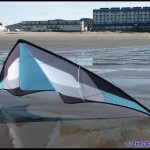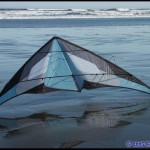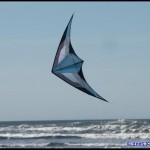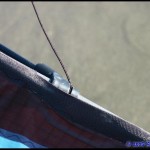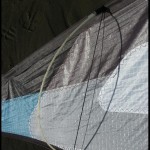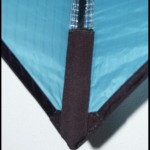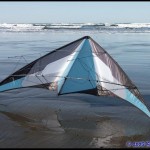 Specifications
Specifications
Manufacturer: Benson Kites
Model: Standard
Wingspan: 2.14m (84″)
Bridle: Semi-Active
Weight: 275g (9.75 oz +15g tail ballast)
Type of kite: Freestyle
Materials: PC-31 Icarex sail with Skyshark P200 / 5PT frame.
Source for test kite: Distributor
Available from these fine retailers: Kite Connection
The long anticipated design from Tim Benson and Andy Wardley is finally available! First seen as the “C-Class” prototype, this kite has been under development for almost two years.
After getting a solid day’s test fly on the Deep Space at the KTAI trade show in Clearwater, we absolutely had to bring one home for further testing and review.
Quality of Construction
The Deep Space is cleanly designed, with almost nothing left uncovered or unseemly… The whisker (stand off) attachments on the sail are completely covered on the back side, reinforced with dacron, and it also features a mylar panel just above the whisker points on the back side to cut down on abrasion during slack line flying.
All the leading edge fittings are covered sufficiently to avoid snags, but not so much as to make rod replacement challenging in any way… They are also internally reinforced to avoid bunching in the sail.
The nose construction is among the best I’ve seen on commercially produced kites, very clean and clearly designed with tricking in mind.
Wing tip attachments are simple, with a knotted line pulled out and over the end, into a notch… This of course makes breaking down your leading edges easy as pie.
The way this kite is designed, it will take quite a bit of abuse and seems to distribute impacts throughout the whole kite as opposed to unfairly stressing one area or another.
Bridle
Using what is referred to as a “semi-active” bridle on Benson’s site, which appears to be a three-point bridle with an activator… Tuning adjustments are only done in one place (traditional), but we flew it on the factory marks and I didn’t find any reason to change things around up to the time of this review.
This kite also satisfies one of my other pet peeves! Near both leading connectors, the bridle is attached by simply tying the end around the spar and locking it down… This enables easy tying and untying, especially when replacing leading edges.
Design Features
The Deep Space has adjustable leech lines that can be tightened or loosened at the tail, the two leech that lines come together in a loop that runs through through the spine end cap and is secured behind a velcro closure.
The leading edges and spine are framed with Skyshark P200s, and the bottom spreaders are done in 5PT tapered rods… A standard 15 gram weight is included with the kite, wrapped in velcro and secured in the tail closure.
The first commercially available kite with roll bars, they have proved to be quite effective in catching and securing the flying lines in a consistant position for roll ups, and particularly multi roll up tricks… And while this is a fairly advanced addition to a kite, it has been done in such a way as to provide very easy set up and break down on the field.
Wind Range
Only having flown this kite in wind speeds of 0-8 mph, we didn’t have a chance to test the Deep Space’s upper limits… But it handled exceptionally well, and is rated for the 5-28 kph range.
Amount of Pull and Sensitivity
The Deep Space is a moderate but affirmative puller, being somewhat smaller than many traditional competition kites… However, the sail does load very nicely and provides sufficient response on the lines.
Responsiveness is excellent, without being overly pitchy or showing an unsuitable amount of oversteer.
Unusual Flight Behaviors
Recoverability, wow! It seemed that no matter how badly I come out of a trick on the Deep Space, it came out with ease and quite often left me set up to go right into another combination… For beginning and intermediate trickers, this might be a slightly less frustrating kite than some of the others out there.
Interesting note , the first time I flew this kite was at the KTAI trade show in Clearwater earlier this year… Alas, the person who’d set it up didn’t have the standard weight with them and I ended up flying without it. While I’d asked for more weight (more than was included) with every other kite I tried at KTAI, the Deep Space was able to do everything I asked of it in the 2-3 mph winds without any weights at all.
Strongest Tricks
By far, the strongest tricks this kite had to offer in my hands were multi roll ups, backspins and multilazies… And while I am very much still just learning the Comet, I found this to be one of the easiest kites to do it on.
If you’ve seen the official first video for this kite, you already know that the Deep Space is a backspin and multilazy machine… One of the things I really enjoyed on this kite was starting in a K2000 (Superstart) and keeping it going in a multilazy, right off the ground.
We also found fades to be incredibly stable… Like, “stake it down and go get lunch while it waits” stable.
Most Challenging Tricks
Hmmm… In my tests, I didn’t find anything that this kite couldn’t do well.
The only observation I have in this area is that the Deep Space tends to be very responsive when on it’s back or in a turtle, taking the flier’s movements more literally and immediately – well illustrated during flic flacs… On the up side, this would give fliers much more reason to watch their hand movements more carefully, providing a nice learning curve.
Precision (corners, tracking, speed)
I’d never been a personal fan of most Benson/Wardley designs in the past since I like a kite with some load and pull behind it, this kite offers a fine balance of trick ability and sail loading… Precision is sharp, with a pleasant snap/buzz accompanying each corner and stall.
Flying Experience
In a market currently dense with trick/freestyle kites, this is one that keeps drawing me along to see what I can do next… I haven’t been disappointed yet.
Tip stabs are affirmative, driving into the ground with sufficient authority.
Snap stalls were a *tad* twitchy but cleaned right up with a little compensation for the kite’s sensitivity… Side slides handled much the same way, and did not tend to lose altitude excessively.
I would describe this kite’s overall speed as medium, zipping enough to be exciting but not so much as to be unpredictable or hard to manage… Speed is more of a factor in pitch tricks however, where the kite seems to respond much more quickly, smaller inputs seemed to smooth things out however.
One of the common problems with many freestyle kites is that during roll ups they tend to collapse a bit as the lines tighten around the kite… The Deep Space held up well, as good as could be expected without a roll cage or other framework to support the pressure that comes with roll ups, particularly multiples.
Summary
The Deep Space is an ideal mid-size kite, whether you’re looking for something as a leisure flier or for competitive use… I feel that it’s well balanced and can satisfy nearly any style of flight.
An excellent ballet kite, it might be a little small for traditional precision judges simply because kites in the 8-9 foot range tend to illustrate the maneuvers more clearly than smaller kites.
Available from these fine retailers: Kite Connection



